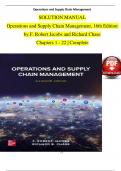1-1 Operations and Supply Chain Management SOLUTION MANUAL Operations and Supply Chain Management, 16th Edition by F. Robert Jacobs and Richard Chase Chapters 1 - 22 | Complete 1-2 Operations and Supply Chain Management TABLE OF CONTENTS Chapter 1: Introduction Chapter 2: Strategy Chapter 3: Design of Products and Services Chapter 4: Projects Chapter 5: Strategic Capacity Management Chapter 6: Learning Curves Chapter 7: Manufacturing Processes Chapter 8: Facility Layout Chapter 9: Service Processes Chapter 10: Waiting Line Analysis and Simulation Chapter 11: Process Design and Analysis Chapter 12: Quality Management Chapter 13: Statistical Quality Control Chapter 14: Lean Supply Chains Chapter 15: Logistics and Distribution Managem ent Chapter 16: Global Sourcing and Procurement Chapter 17: The Internet of Things and ERP Chapter 18: Forecasting Chapter 19: Sales and Operations Planning Chapter 20: Inventory Management Chapter 21: Material Requirements Planning Chapter 22: Workcenter Scheduling 1-3 Operations and Supply Chain Management CHAPTER 1 OPERATIONS AND SUPPLY CHAIN MANAGEMENT Discussion Questions 1. Using Exhibit 1.3 as a model, describe the source -make -deliver -return relationships in the following systems: a. An airline Source: Aircraft manufacturer, in-flight food, repair parts, computer systems Make: Aircraft and flight crew scheduling, ground services provided at airports, aircraft maintenance and repair Deliver: Outbound and arriving passenger service, baggage handling Return: Resolve any post -service issues such as lost or damaged luggage b. An automobile manufacturer Source: Suppliers of components and raw materials Make: Manufacturing of vehicles and components or subassemblies to be sold as spare parts Deliver: Delivery to and sales from dealerships, delivery of spare parts to the wholesale system Return: Warranty and recall repairs, trade -ins c. A hospital Source: Medical supplies, cleaning services, disposal services, food services, qualified personnel Make: Inpatient rooms, outpatient clinics, emergency room, operating rooms Deliver: Scheduling patients, providing treatment, ambulance service, family counseling Return: Billing errors, follow up visits d. An insurance company Source: Supplies needed for the office, underwriters, legal authority to operate 1-4 Operations and Supply Chain Management Make: Establish policy guidelines and pricing, field agent/representative and facility network, develop Internet service capabilities, establish preferred vehicle repair service network Deliver: Meet with and advise clients, write policies, process and pay claims Return: refund of overpayments 2. Define the service package of your college or university. What is its strongest element? What is its weakest one? The categories with examples are: Supporting facility - location, buildings, labs, parking Facilitating goods – class schedules, computers, books, chalk Explicit services – classes with qualified instructors, placement offices Implicit services – status and reputation (e.g., Ivy League schools) At Indiana University and the University of Southern California, among their strongest elements are their business schools and their Operations Management programs (of course). Both also have very dedicated alumni networks. A weak elem ent of Indiana University is its weak football program; for USC, weak elements are on -campus parking and housing. 3. What service industry has impressed you the most with its innovativeness? Our vote goes to cruise lines which have introduced such onboard innovations as wave machines for belly boarding and rock climbing walls, as well as all sorts of other amenities to keep cruisers involved. The industry is doing record business as well. Some of the standout companies in less innovative industries are Ban k of America (has a formalized research program to try out new customer services/amenities such as video screens in next to teller lines), Intuit (e.g., putting Quicken money management software online), Ikea, JetBlue Airlines, and Progressive Insurance (d iscussed later in the book). 4. What is product -service bundling and what are the benefits to customers? Product -service bundling is adding Value -added services to a firm’s product offerings to create more value for the customer. This provides benefits in two areas. First, this differentiates the organization from the competition. Secondly, these services tie customers to the organization in a positive way. Alternatively, bundling can also involve adding products to a service, for example, adding the sale o f convenience items and snacks at a hotel. 5. What is the difference between a service and a good? A service is an intangible process (you can’t hold it in your hands), while a good is the physical output of a process. 6. Look at the job postings at http://www.indeed.com and evaluate the opportunities for an OSM major with several years of experience.





